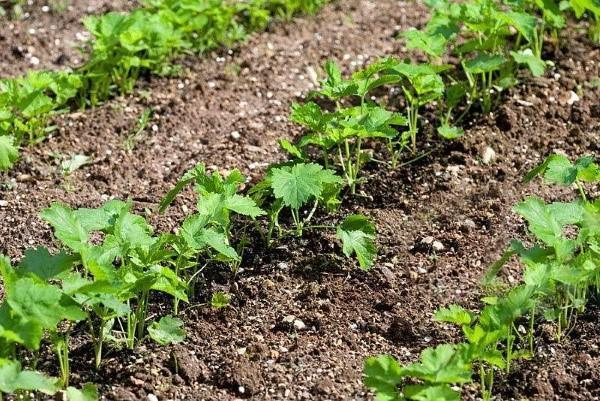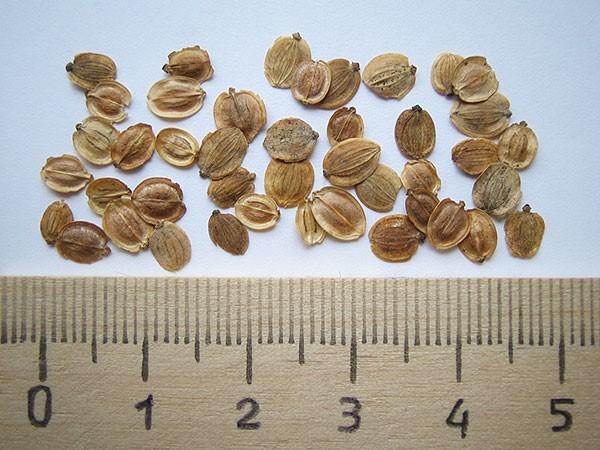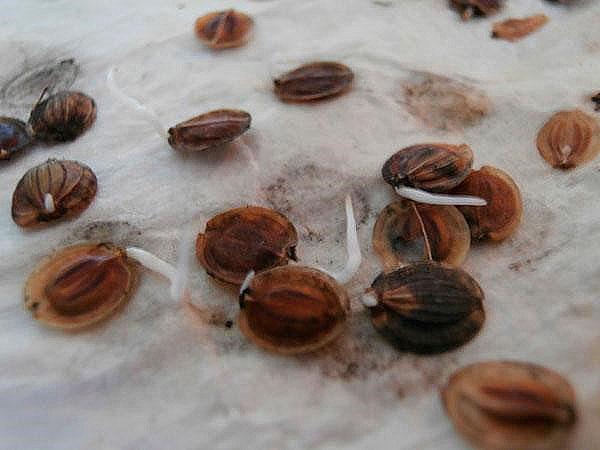Growing parsnips from seeds - all the nuances from sowing to harvesting
 It is not always possible to find parsnips in garden beds, because due to the low germination of seeds, most gardeners prefer to buy the root crop already "ready". And it is completely in vain, because growing parsnips from seeds is a rather simple procedure. Of course, the essential oils in seeds do not improve their planting characteristics in any way. At the same time, parsnip is one of the most cold-resistant plants, so there will be no problems with it in this matter. Knowing the intricacies of the sowing process and the features of plant care, it is quite possible to get a good harvest. And also - to provide yourself with seed for the next season. How to grow healthy parsnips from seeds? We will talk about this in detail today.
It is not always possible to find parsnips in garden beds, because due to the low germination of seeds, most gardeners prefer to buy the root crop already "ready". And it is completely in vain, because growing parsnips from seeds is a rather simple procedure. Of course, the essential oils in seeds do not improve their planting characteristics in any way. At the same time, parsnip is one of the most cold-resistant plants, so there will be no problems with it in this matter. Knowing the intricacies of the sowing process and the features of plant care, it is quite possible to get a good harvest. And also - to provide yourself with seed for the next season. How to grow healthy parsnips from seeds? We will talk about this in detail today.
How to increase germination and prepare seeds for sowing

To grow root parsnips, only fresh seeds should be used. In the second year of storage, their germination drops sharply.
To get the maximum result, it is recommended to soak the seeds for a couple of days before sowing. You can do this in two ways, using:
You can do this in two ways, using:
- Plain water.
- Ash solution (20 g per liter of water).
At the end of the procedure, the seeds need to be rinsed again and spread out to dry out. They are now ready for seeding.
When to plant parsnips
 Although parsnips are not afraid of the cold and return frosts are nothing to it, it is important to follow the recommendations regarding planting dates. To nullify all efforts can be too early or late landing. In cold ground, seeds will disappear and rot before sprouting.
Although parsnips are not afraid of the cold and return frosts are nothing to it, it is important to follow the recommendations regarding planting dates. To nullify all efforts can be too early or late landing. In cold ground, seeds will disappear and rot before sprouting.
The ground has warmed up to 10 ° C, which means that the time has come when parsnips can be sown in open ground.
When it comes to seedlings, this method is not very suitable for parsnips. No, the seeds are capable of and will even sprout at home, but transplanting for seedlings can end in failure. The beautiful and even shape of the spine is deformed as a result of this procedure. But it is she who is the main goal of the gardener.
Regarding the specific dates of sowing in the soil, they depend on the desire of the gardener and a little on the local climate. In general, this can be done both in early spring and before winter. In spring, parsnips can be sown early, when the ground warms up to the above rate. Depending on the region of cultivation, this can be in April or May. The last option concerns the northern regions, because the heat comes there later. Do not do this before. Although the seeds are difficult to germinate and lie in the ground for at least 3 weeks, during this time they can disappear without heat.
 Planting parsnips before winter begins at the end of September. The deadline for autumn sowing is the second decade of October. The seeds will overwinter well in the garden, and in the spring it will only be necessary to thin out the seedlings.
Planting parsnips before winter begins at the end of September. The deadline for autumn sowing is the second decade of October. The seeds will overwinter well in the garden, and in the spring it will only be necessary to thin out the seedlings.
When sowing in winter, the seeds should not be soaked.
Agrotechnics of growing parsnips: where and how to sow
 Insensitive to cold, this plant nevertheless loves warmth and sun.It is better to choose a place for it so that it is sunny during the day. With sufficient light, the fruit will be larger. However, as an option, in extreme cases, you can sow seeds in partial shade. The harvest, although not so rich, can be obtained there as well.
Insensitive to cold, this plant nevertheless loves warmth and sun.It is better to choose a place for it so that it is sunny during the day. With sufficient light, the fruit will be larger. However, as an option, in extreme cases, you can sow seeds in partial shade. The harvest, although not so rich, can be obtained there as well.
Choosing a place for parsnips
 Ideally, if on the site where you plan to grow parsnips, before it grew:
Ideally, if on the site where you plan to grow parsnips, before it grew:
But beds with related crops (carrots, parsley, celery) can "reward" parsnips with diseases. It is not worth planting in the place of these plants.
Too acidic and moist soils are not suitable for parsnips. And he feels best of all on peat and sandy loam lands and in loams.
Growing parsnips in the open field also includes preliminary soil preparation. Even during the autumn digging, organics and minerals are added to the site. It is good to use humus or compost from organic fertilizers. From "chemistry" for parsnips, a complex is suitable, including nitrate (10 g), potassium salt (25 g) and superphosphate (30 g) per 1 sq. m.
From "chemistry" for parsnips, a complex is suitable, including nitrate (10 g), potassium salt (25 g) and superphosphate (30 g) per 1 sq. m.
It is categorically impossible to use fresh manure as a fertilizer for parsnip beds. From it, the roots will begin to form lateral branches.
Planting technique for parsnips
 Some gardeners make separate holes with a distance of 10 cm and spread several seeds there. However, it will be much more convenient to plant them in long rows, while the sowing should be thick, "in reserve". Given the low germination rate, this will help to avoid voids in the garden bed, and excess seedlings can always be thinned out. In this case, you need to leave from 30 to 50 cm between the rows, so that it is convenient to care for the plants.
Some gardeners make separate holes with a distance of 10 cm and spread several seeds there. However, it will be much more convenient to plant them in long rows, while the sowing should be thick, "in reserve". Given the low germination rate, this will help to avoid voids in the garden bed, and excess seedlings can always be thinned out. In this case, you need to leave from 30 to 50 cm between the rows, so that it is convenient to care for the plants.
Since the weeds will fill the beds before the shoots appear, the parsnips can be sown together with the radishes. It rises quickly and marks the sowing site, making it easier to weed. And by the time the parsnip itself sprouts, the radish can be pulled out for salad.
Caring for parsnips in the garden: from emergence to harvest
Sowing and caring for parsnips is like growing carrots and in general it is. The agricultural technology of these crops is almost the same. However, unlike carrots, parsnip roots winter well in the open field and even taste better. Having pleased in the first year with fruits, the plants remaining in the garden in the second year of life will give seeds.
Caring for seed-grown parsnips includes the following procedures:
- Thinning. When the seedlings form a pair of leaves, they free up space for root development. To do this, extra seedlings are pulled out at a distance of 5 cm. If the soil is very nutritious, you will need twice as much space (up to 10 cm). If necessary, a second thinning is carried out when the bushes grow to 8 cm.

- Weeding and loosening. To weeds parsnips were not hammered, they are pulled out in a timely manner. Row spacings should be loosened carefully and after every watering and rain.

- Watering. Like all root vegetables, parsnips love water and are picky about frequent watering. Otherwise, the fruit will start to crack.

- Top dressing. On rich and fertile soil, parsnips can do without them, but not everyone can boast of such land. For a good harvest, the beds need to be fertilized at least three times per season. The first two dressings are nitrogen, at the age of 2 and 6 weeks after germination. The latter is potassium-phosphorus (in the form of a solution), from the second half of summer.

Parsnips are harvested in the fall, from late September to October. It is carefully dug out with a pitchfork, the tops are cut and dried. After that, the fruits can be brought into the cellar for storage by placing them in a box of sand.
 However, if there is nowhere to store, you can dig out only part of the beds, leaving the rest to winter. Then in the spring there will be fresh vitamins on the table - the main thing is to have time to dig up the fruits before they start growing.Then the parsnip begins to grow a branchy stem to the detriment of the palatability of the fruit. But in June, the abandoned bushes will bloom, and you can collect your own planting material to continue growing parsnips from seeds.
However, if there is nowhere to store, you can dig out only part of the beds, leaving the rest to winter. Then in the spring there will be fresh vitamins on the table - the main thing is to have time to dig up the fruits before they start growing.Then the parsnip begins to grow a branchy stem to the detriment of the palatability of the fruit. But in June, the abandoned bushes will bloom, and you can collect your own planting material to continue growing parsnips from seeds.